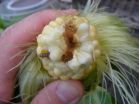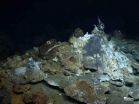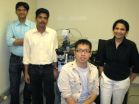(Press-News.org) Photosynthesis is the process used by plants to convert atmospheric carbon dioxide into the energy-rich chemicals upon which all life-forms depend. The energy trapped in these compounds comes from sunlight, and photosynthetic organisms – plants, algae and certain types of bacteria – capture this energy in a usable form with the help of protein complexes called photosystems. Photosystems include antenna proteins that collect incident light, and green plants have two sorts of photosystems, which respond best to light of different wavelengths. A team of researchers at LMU, led by Professor Dario Leister, has now identified a protein named PAM68 that is essential for the assembly of Photosystem II in green plants. The protein is also found in photosynthetic cyanobacteria, but there it serves a different function. "It turns out that PAM68 itself does not form part of the functional photosystem II at all", says Leister. In the longer term, the new finding may make it possible to improve the yields of important crops and might even form the basis for new types of solar cells. (Plant Cell online, 5 October 2010)
Photosynthesis can be thought of as the central pillar of the biosphere, because this set of biochemical reactions provides the oxygen and energy-rich foodstuffs upon which other organisms, including humans, subsist. The energy for the process comes from sunlight, and is captured by molecules that act as solar collectors in photosynthetic organisms, such as plants, algae and cyanobacteria. "All of these organisms possess two different photosystems, each of which responds most efficiently to light of a particular wavelength", says Professor Dario Leister of the Department of Biology I at LMU Munich.
The photosystems consist of light-absorbing chlorophyll pigments and a variety of proteins. "Assembly of these multiprotein complexes takes place in several steps and requires the participation of specific accessory proteins", explains Leister. In their latest study, he and his team set out to identify assembly factors necessary for correct formation of photosystem II in the model plant thale cress (Arabidopsis thaliana) and in the cyanobacterial species Synechocystis. They showed that a previously unknown protein, which they called PAM68, interacts with several of the components of photosystem II and is required to put the functional complex together.
"PAM68 is found in both the plant and the cyanobacterium", Leister points out, "but it has quite different functions in the two organisms." In both cases, the newly discovered assembly factor is essential for the first steps in the construction of Photosystem II. In thale cress mutants that lack PAM68, however, these early intermediates accumulate. Inactivation of the cyanobacterial protein, on the other hand, actually facilitates the assembly of larger complexes. Strikingly, although it is required in the building of Photosystem II, PAM68 is not a member of the fully assembled, functional complex. "This is one case where the whole is less than the sum of the parts", says Leister.
The new work has uncovered common features of plant and bacterial photosynthesis, but also points to distinct differences between the two. "In the long term, a comprehensive understanding of the function of Photosystems I and II should enable us to utilize solar energy more efficiently", says Leister. It could, for instance, contribute to the development of artificial systems that mimic photosynthesis, perhaps leading to new types of solar cell. The new results will also be of interest to agronomists, as they suggest that it should be possible to produce more robust strains of crop plants that can cope with higher levels of light stress and produce better yields. At all events, Leister and his team will continue their quest for the new factors involved in photosystem assembly. (CA/suwe)
INFORMATION:
Publication:
The Arabidopsis thylakoid protein PAM68 is required for efficient D1 biogenesis and photosystem II assembly
Ute Armbruster, Jessica Zühlke, Birgit Rengstl, Renate Kreller, Elina Makarenko, Thilo
Rühle, Danja Schünemann, Peter Jahns, Bernd Weisshaar, Jörg Nickelsen, Dario Leister;
Plant Cell online, 5 October 2010
DOI: 10.1105/tpc.110.077453
The elusive intermediary
Newly discovered protein may help to improve crop yields
2010-10-08
ELSE PRESS RELEASES FROM THIS DATE:
Report examines effects of noise and recommends ways to reduce levels
2010-10-08
Exposure to noise is a fact of life. At high levels, noise can damage hearing, and at lower levels it can disrupt sleep patterns, interfere with communications, and even cause accidents. A new National Academy of Engineering report characterizes the most commonly identified sources of noise, looks at efforts that have been made to reduce noise emissions, and suggests ways to decrease exposure in workplaces, schools, recreational environments, and residences.
Development of noise control technology needs immediate attention, said the committee that wrote the report. America ...
NIH funds advanced development of 3 biodefense vaccines
2010-10-08
###
For more information, visit NIAID's Vaccines Web site at http://www.niaid.nih.gov/topics/vaccines/Pages/Default.aspx and Biodefense Web site at http://www.niaid.nih.gov/topics/biodefenserelated/Pages/default.aspx.
NIAID conducts and supports research-at NIH, throughout the United States, and worldwide to study the causes of infectious and immune-mediated diseases, and to develop better means of preventing, diagnosing and treating these illnesses. News releases, fact sheets and other NIAID-related materials are available on the NIAID Web site at http://www.niaid.nih.gov.
The ...
Despite highest health spending, Americans' life expectancy falls behind other countries'
2010-10-08
October 7, 2010—America continues to lag behind other nations when it comes to gains in life expectancy, and commonly cited causes for our poor performance—obesity, smoking, traffic fatalities and homicide—are not to blame, according to a study by researchers at Columbia University's Mailman School of Public Health. The study looked at health spending; behavioral risk factors like obesity and smoking; and 15-year survival rates for men and women ages 45 and 65 in the U.S. and 12 other nations -- Australia, Austria, Belgium, Canada, France, Germany, Italy, Japan, the Netherlands, ...
Transgenic corn suppresses European corn borer, saves farmers billions
2010-10-08
Transgenic corn's suppression of the European corn borer has saved Midwest farmers billions of dollars in the past decade, reports a new study in Science.
Research conducted by several Midwest universities shows that suppression of this pest has saved $3.2 billion for corn growers in Illinois, Minnesota, and Wisconsin over the past 14 years with more than $2.4 billion of this total benefiting non-Bt corn growers. Comparable estimates for Iowa and Nebraska are $3.6 billion in total, with $1.9 billion accruing for non-Bt corn growers.
Transgenic corn is engineered to ...
Tinnitus in the elderly is prevalent and impacts quality of life
2010-10-08
Alexandria, VA — Tinnitus is common among elderly Nigerians and associated with treatable health conditions like otitis media, rhinosinusitis, head injury and hypertension, according to new research published in the October 2010 issue of Otolaryngology – Head and Neck Surgery.
Nearly 36 million Americans, however, suffer from tinnitus or head noises. It may be an intermittent sound or an annoying continuous sound in one or both ears. In Nigeria, tinnitus affects between 10.1% and 33% of the population, with about 3 to 4% consulting a doctor on at least one occasion in ...
New deep-sea hot springs discovered in the Atlantic
2010-10-08
Scientists from the MARUM Center for Marine Environmental Sciences and the Max Planck Institute for Marine Microbiology in Bremen on board the German research vessel Meteor have discovered a new hydrothermal vent 500 kilometres south-west of the Azores. The vent with chimneys as high as one meter and fluids with temperatures up to 300 degrees Celsius was found at one thousand metres water depth in the middle of the Atlantic Ocean. The discovery of the new deep-sea vent is remarkable because the area in which it was found has been intensively studied during previous research ...
Novel protein critical for cellular proliferation discovered
2010-10-08
Accurate duplication of genetic material and the faithful segregation of chromosomes are critical for cell survival. The initiation of DNA replication is linked both to cell cycle progression and chromatin organization. In plants, animals and other "eukaryotes," the assembly of a multi-protein complex called pre-replicative complex (preRC) is the first step in the initiation of DNA replication. As the name implies, origin recognition complex (ORC) proteins bind to origins of DNA replication. Subsequently, other components of preRC are assembled at these sites. In addition ...
An X-ray for your genes
2010-10-08
Prescription drugs and their dosages may be standardized, but not every patient reacts to a medicine in the same way. The personal genetic characteristics of individuals and populations can explain why a specific prescription successfully treats one patient and not another, so medical researchers are adopting the new approach called "personalized medicine" and a Tel Aviv University lab is leading the way.
Dr. Noam Shomron of Tel Aviv University's Sackler Faculty of Medicine is developing a new method for the advancement of personalized medicine, an expanding area of ...
Queen's University discovery could impact how the body receives medicine
2010-10-08
Researchers at Queen's University have discovered how molecules in glass or plastic are able to move when exposed to light from a laser. The findings could one day be used to facilitate medicinal drug distribution by allowing doctors to control the time and rate at which drugs are delivered into the body. The drugs, in a solid plastic carrier, could be released through the body when exposed to light.
Lead researcher Jean-Michel Nunzi, a professor in the departments of Chemistry and Physics, has determined that "molecular cooperation" is what allows the molecules to move ...
You may not be able to say how you feel about your race
2010-10-08
INDIANAPOLIS –A new study from the School of Science at Indiana University-Purdue University Indianapolis looks at how much African Americans and whites favor or prefer their own racial group over the other, how much they identify with their own racial group, and how positively they feel about themselves.
The work, by Leslie Ashburn-Nardo, Ph.D., associate professor of psychology in the School of Science at IUPUI, looked at both consciously controllable sentiments and gut feelings about social stigma and found a significant difference in both groups between what people ...
LAST 30 PRESS RELEASES:
Ticking time bomb: Some farmers report as many as 70 tick encounters over a 6-month period
Turning garden and crop waste into plastics
Scientists discover ‘platypus galaxies’ in the early universe
Seeing thyroid cancer in a new light: when AI meets label-free imaging in the operating room
Neutrophil-to-lymphocyte ratio may aid risk stratification in depressive disorder
2026 Seismological Society of America Annual Meeting
AI-powered ECG analysis offers promising path for early detection of chronic obstructive pulmonary disease, says Mount Sinai researchers
GIMM uncovers flaws in lab-grown heart cells and paves the way for improved treatments
Cracking the evolutionary code of sleep
Medications could help the aging brain cope with surgery, memory impairment
Back pain linked to worse sleep years later in men over 65, according to study
CDC urges ‘shared decision-making’ on some childhood vaccines; many unclear about what that means
New research finds that an ‘equal treatment’ approach to economic opportunity advertising can backfire
Researchers create shape-shifting, self-navigating microparticles
Science army mobilizes to map US soil microbiome
Researchers develop new tools to turn grain crops into biosensors
Do supervised consumption sites bring increased crime? Study suggests that’s a myth
New mass spec innovation could transform research
Maternal nativity, race, and ethnicity and infant mortality in the US
Migration-related trauma among asylum seekers exposed to the migrant protection protocols
Jupiter’s moon Europa has a seafloor that may be quiet and lifeless
SwRI upgrades nuclear magnetic resonance laboratory for pharmaceutical R&D
House sparrows in northern Norway can help us save other endangered animals
Crohn's & Colitis Foundation survey reveals more than 1/3 of young adults with IBD face step therapy insurance barriers
Tethered UAV autonomous knotting on environmental structures for transport
Decentralized social media platforms unlock authentic consumer feedback
American Pediatric Society announces Vanderbilt University School of Medicine as host institution for APS Howland Visiting Professor Program
Scientists discover first method to safely back up quantum information
A role for orange pigments in birds and human redheads
Pathways to net-zero greenhouse gas emissions for Southeast Asia
[Press-News.org] The elusive intermediaryNewly discovered protein may help to improve crop yields



